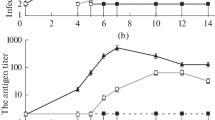Summary
Several vaccinia virus recombinants inducing the synthesis of the middle surface (M) protein of hepatitis B virus (HBV) were constructed. One of them, denoted vl37, was examined in some detail. The virus replicated nearly to the same extent in various cell lines, viz. human embryo diploid fibroblast LEP and MRC-5 cells, rabbit embryo fibroblast REF cells, TK− rat RAT-2 cells, and green monkey CV-1 cells. However, the production of M protein was found considerably lower in the human LEP and MRC-5 than in the other cells examined. In addition, the kinetics of M formation were different in these two cell systems, LEP cells lagging significantly behind CV-1 cells. The low-level production of M protein in LEP cells was not increased by repeated vl37 passages in LEP cells, nor by a passage in a laboratory worker accidentally infected with the vl37 virus, nor by shortening the leader sequence preceding the translation initiation codon. The greater part of the M antigen was found to be cell associated, more so in the cells of human than monkey origin. From the major HBV S antigen (HBsAg) isolated from the plasma of chronically infected subjects, the antigen released by cell destruction differed by binding to polymerized human albumin. This property was utilized in ELISA to detect anti-preS2 antibody. Rabbits inoculated intradermally with the vl37 virus developed antibodies reactive in this assay as well as with a synthetic peptide corresponding in the amino acids 14–34 of the NH2terminus of the HBsAg preS2 region.
Similar content being viewed by others
References
Budkowska A, Riottot MM, Dubreil P, Lazizi Y, Brechot CH, Sobczak E, Petit MA, Pillot J (1986) Monoclonal antibody recognizing preS2 epitope and anti-preS2 antibody. J Med Virol 20: 111–125
Chakrabarti S, Robert-Guroff M, Wong-Stall F, Gallo RC, Moss B (1986) Expression of the HTLV-III envelope gene by a recombinant vaccinia virus. Nature 320: 535–537
Chelyapov NV, Chernos VI, Andznaparidze OG (1988) Analysis of antibody production to vaccinia virus in man and rabbits in response to inoculation of a recombinant vaccinia hepatits B vaccine. Vopr Virusol 2: 175–179
Chelyapov NV, Antonova TP, Yanova NN, Chernos VI (1988) Antigenic properties of vaccinia virus and of the virus recombinants strains expressing heterologous genes. Acta Virol 32: 409–416
Cheng KCH, Smith GL, Moss B (1986) Hepatitis B virus large surface protein is not secreted but is immunogenic when selectively expressed by recombinant vaccinia virus. J Virol 60: 337–344
Cheng KC, Moss B (1987) Selective synthesis and secretion of particles composed of the hepatitis B virus middle surface protein directed by a recombinant vaccinia virus: induction of antibodies to pre-S and S epitopes. J Virol 61: 1286–1290
Fuerst TR, Earl PL, Moss B (1987) Use of a hybrid vaccinia virus T7 RNA polymerase systems for expression of target genes. Mol Cell Biol 7: 2538–2544
Gilbert JH, Pedersen NC, Nunberg JH (1987) Feline leukemia virus envelope protein expression encoded by a recombinant vaccinia virus: apparent lack of immunogenicity in vaccinated animals. Virus Res 7: 49–67
Hamšíková E, Závadová H, Zaoral M, Ježek J, Bláha I, Vonka V (1987) Immunogenicity of a synthetic peptide corresponding to a portion of the heavy chain of H3N2 influenza virus haemagglutinin. J Gen Virol 68: 2249–2252
Kutinová L, Vonka V, Brouček J (1973) Increased oncogenicity and synthesis of herpesvirus antigens in hamster cells exposed to herpes simplex type 2 virus. J Natl Cancer Inst 50: 759–766
Mackett M, Smith GL, Moss B (1982) Vaccinia virus: a selective eukaryotic cloning and expression vector. Proc Natl Acad Sci USA 79: 7415–7419
Mackett M, Smith GL, Moss B (1984) General method for production and selection of infectious vaccinia virus recombinants expressing foreign genes. J Virol 49: 857–864
McLachlan A, Milich DR, Raney AK, Riggs MG, Hughes JL, Sorge J, Chisari FV (1987) Expression of hepatitis B virus surface and core antigens: influences of pre-S and precore sequences. J Virol 61: 683–692
Michl J (1961) Metabolism of cells in tissue culture in vitro. I. The influence of serum protein fractions on the growth of normal and neoplastic cells. Exp Cell Res 23: 324–330
Moss B, Flexner CH (1987) Vaccinia virus expression vectors. Annu Rev Immunol 5: 305–324
Panicali D, Paoletti E (1982) Construction of poxviruses as cloning vectors: insertion of the thymidine kinase gene from herpes simplex virus into the DNA of infectious vaccinia virus. Proc Natl Acad Sci USA 79: 4927–4931
Paoletti E, Lipinska BR, Samsonoff C, Mercer S, Panicali D (1984) Construction of live vaccines using genetically engineered poxviruses: biological activity of vaccinia virus recombinants expressing the hepatitis B virus surface antigen and the herpes simplex virus glycoproteins D. Proc Natl Acad Sci USA 81: 193–197
Pourcel C, Louise S, Gervais M, Chenciner N, Dubois MF, Tiollais P (1982) Transcription of the hepatitis B surface antigen gene in mouse cells transformed with cloned viral DNA. J Virol 42: 100–105
Slonim D, Hulenová M (1969) Study of plaque titration of vaccinia virus in chick embryo cell cultures. I. Assays under an agar overlay. Acta Virol 13: 209–215
Smith GL, Mackett M, Moss B (1983) Infectious vaccinia virus recombinants that express hepatitis B virus surface antigen. Nature 302: 490–495
Standring DN, Ou JH, Rutter WJ (1986) Assembly of viral particles in Xenopus oocytes: pre-surface-antigens regulate secretion of the hepatitis B viral surface envelope particle. Proc Natl Acad Sci USA 83: 9338–9342
Thomas G, Thomas L, Thorne B, Herbert E (1988) Cell-type specific processing of neuroendocrine precursor proteins using vaccinia recombinants. Biochemie 70: 89–97
Topp WC (1981) Normal rat cell lines deficient in nuclear thymidine kinase. Virology 113: 408–411
Author information
Authors and Affiliations
Rights and permissions
About this article
Cite this article
Kutinová, L., Němečková, Š., Hamšíková, E. et al. A recombinant vaccinia virus expressing hepatitis B virus middle surface protein Restricted expression of HBV antigens in human diploid cells. Archives of Virology 112, 181–193 (1990). https://doi.org/10.1007/BF01323163
Received:
Accepted:
Issue Date:
DOI: https://doi.org/10.1007/BF01323163




